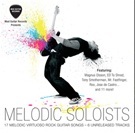Minor Pentatonic Chord Building: More than Just 5 Notes

I wanted to take the opportunity to dive into the Pentatonic Scale and do a little creative exercise in chord construction. The Pentatonic Scale has been given the stereotype that it’s just for blues and mainly for soloing. Not only are there solo applications but there is a way to substitute minor chords with forms shaped right out of the relative Pentatonic Minor Scale. Not all of these forms will be pleasant to the ear at first and you may favor certain forms over others but experimentation is the key focus of this article.
The first example here explains the Intervals of the Pentatonic Scale so you can see what types we are dealing with (If you need more work on Intervals may I suggest checking out my lesson “Understanding Intervals” available at http://joepinnavaia.weebly.com/lessons.html). The second example plays the intervals together so we can get a better idea of what they sound like and their sonorities – Major, Minor, 4th, 5th etc. This is useful for ear training and being able to tell the difference between Major, Minor etc.
Example three is an idea that employs double stops that are basically a 4th apart. You can use this in a variety of ways so my suggestion would be to use them going up the fretboard on just two strings at a time and also diagonally as well. Use your creative mind to switch up the positions as you play them.
Example four is using double stops but they are spread further apart by skipping a string in between. Technically the intervals range from a major 6th to a minor 7th – but why get technical! Experiment with making the distances wider and try mixing it up – remember, there are no right or wrong answers only your creativity that will show you how you will use these ideas.
Example five uses double stops just on two strings and ascends the fretboard while inverting the fingering of each interval which creates harmonic movement.
Example six uses three note chords that are shaped right out of the pentatonic boxes and moves up the fretboard. I like using these forms a lot in minor chord vamps because it sticks right along with the minor vibe and doesn’t get in the way while creating a lot of movement.
Example seven further expands on the previous forms with some more harmonic movement within the chord forms by way of using the box form and their application is the same with expanding a minor chord.
Example eight shows you how to take some other unconventional shapes in a descending run – again three note chord shapes that help to spice up any minor chord progression.
Example nine is another way of further expanding the pentatonic scale by using chords that have the intervals spread out with only two notes on the 6th and 5th strings and 2nd and 1st strings. Another creative way of building these chords would be using a static voicing with changing bass notes to give movement. Try this and listen to other types of harmonies opening up right in front of you.
I hope you enjoyed this lesson and I wish you luck in you musical journey. If there are any specific topics you would like me to write about I would be happy to do so. You can email me at testtuberhino@gmail.com.
Joe Pinnavaia is a guitarist/composer from the Western New York area and has performed on several records and his solo release”InVitro” is now available through Steve Vai’s Digital Nations at www.digital-nations.com/artists/testtuberhino
For more downloadable lessons please visit – http://www.joepinnavaia.weeble.com










